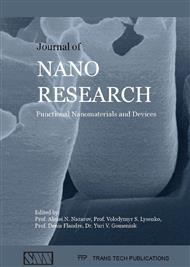p.162
p.169
p.178
p.191
p.202
p.214
p.221
p.228
p.235
Selected Questions Related to Characterization of MEMS Structures Comprising PZT Piezo Layer
Abstract:
PZT (lead zirconium titanate) is an intermetallic compound exhibiting piezoelectric, ferroelectric, and pyroelectric properties. The perovskite crystallographic structure of the PZT is responsible for the above effects. MEMS structures with piezo layers can be used as sensors, actuators, or converters. The abilities of piezo materials to generate an electric charge as a response to stress and a change of shape as a response to electric field are very attractive in numerous applications. Cantilever structures with a mass attached can accordingly be used as energy harvesters converting energy of environment vibrations. Other applications of cantilevers are small displacement sensors or actuators in micro/nanoscale. Membrane structures can work as ultrasonic transducers. If properly shaped cavity is produced, the structure may be used as a part of ink printer head or as a pressure sensor.For physical description of piezo phenomena, constitutive equations in several forms are used. They work well for bulk piezoelectric, although for thin layers deposited on silicon or similar substrate, piezoelectric coupling coefficients must be redefined because of the interaction of thin piezo layer and thicker substrate.Typical electric characterization of piezo MEMS structures includes CV and IV measurements. QV (charge-voltage) hysteresis loop study is an additional method used for this characterization. Complex electromechanical methods are used for surveying piezoelectric coupling coefficients. These methods employ mechanic actuation and electric response Q measurements or AC electric V (voltage) excitation and measurement of mechanical response v (velocity). In the second case, a very precise tool for velocity evaluation is necessary. Such tool could be for example laser Doppler vibrometer, enabling measurements of picometer resolution in several MHz bandwidth. In many cases resonance features of structures have revealed themselves interesting and became a subject of the study. Some vibrometers make measurement of micro cantilever vibrations excited by Brownian movement of air particles possible.
Info:
Periodical:
Pages:
202-213
Citation:
Online since:
February 2016
Authors:
Price:
Сopyright:
© 2016 Trans Tech Publications Ltd. All Rights Reserved
Share:
Citation:


